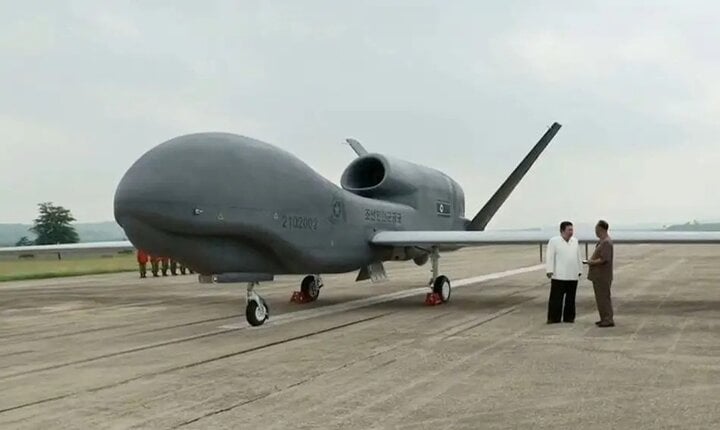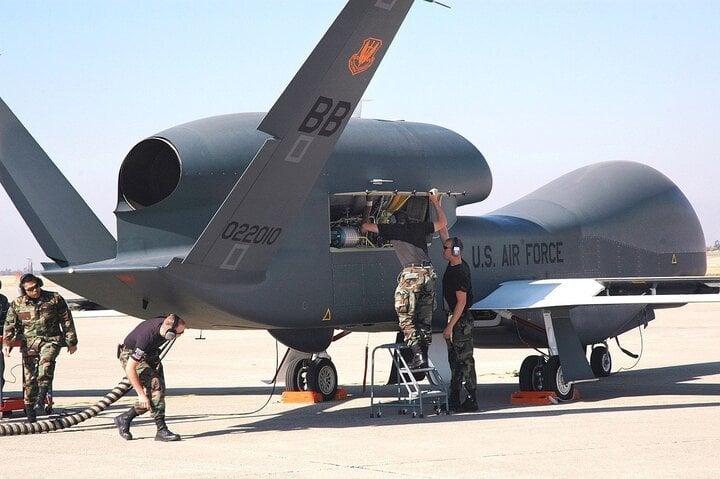Korean Central Television station KCTV on January 15 broadcast a documentary, recording leader Kim Jong-un inspecting the air base that operates the most modern unmanned aerial vehicles (UAVs) of the country. this country.
In the film, in addition to testing sniper rifles and driving armored personnel carriers, Mr. Kim also inspected drones produced by North Korea. The filming period was not disclosed, but Mr. Kim’s outfit suggested the visit appeared to take place in the summer and fall of 2023.
The two aircraft appearing in the video have a similar appearance to the US Air Force’s RQ-Q Global Hawk nicknamed “Evil Bird” and MQ-9 Reaper nicknamed “Death”.
Western military experts say that they are almost copies of the RQ-4 Global Hawk and MQ-9 Reaper lines developed by the US. This pair of UAVs includes a strategic reconnaissance UAV named Saetbyul-4 (Sao Mai-4) and a multi-purpose attack UAV Saetbyul-9 (Sao Mai-9).

Leader Kim Jong-un inspected a UAV model similar in shape to the US RQ-4 Global Hawk.
Saetbyul-4 has a bulging body design similar to Global Hawk, this is a reconnaissance UAV model. Saetbyul-9 is an attack UAV model like the Reaper, capable of carrying many types of weapons such as glide bombs and air-to-ground missiles.
North Korea introduced the above two UAV models at the arms exhibition and during the military parade held in July 2023, releasing images of them flying over the capital Pyongyang, showing that both are machines. working plane, not a static model for display on the ground. However, the technical specifications of Saetbyol-4 and Saetbyol-9 are still kept secret by Pyongyang.
“ The shape and dimensions indicate that Saetbyol-4 is designed to operate at high altitudes and long distances. The US version of the RQ-4A can operate continuously for more than 30 hours, performing reconnaissance and reconnaissance missions, equipped with image and signal intelligence sensors as well as moving target marking . , commented US military expert Tyler Rogoway.
Meanwhile, satellite images show that the Saetbyol-9 has a wingspan of 19.8 m, slightly less than the 20.1 m wingspan of the MQ-9 Reaper. It once appeared at the exhibition in Pyongyang with 6 weapon pylons under the wings, accompanied by surface-to-surface missiles shaped like the American AGM-114 Hellfire series.
Some experts are impressed with North Korea’s copying capabilities but remain skeptical about the true capabilities of Saetbyol-4 and Saetbyol-9. To date, Pyongyang still does not possess a dense satellite network, so its UAVs cannot operate too far from their base if they want to maintain high-speed data transmission and time control capabilities. their activities.

US UAV RQ-4 Global Hawk.
“ The high-tech sensors of the RQ-4 and MQ-9 series remain out of Pyongyang’s reach, even if it has spy networks abroad. That could force North Korea to equip copied UAVs with much less capable equipment. The complex composite structure inside the aircraft and engine is also a significant obstacle, which can significantly limit the flight range and operating ceiling of these UAVs ,” Rogoway stated.
It is unclear how North Korea develops UAV models similar to US aircraft. Iran has also successfully copied a series of US UAVs, including the RQ-170 Sentinel stealth reconnaissance aircraft. In 2019, Iran also shot down and recovered the remains of an RQ-4N “BAMS-D” to serve research on this UAV line.
” The birth of these two aircraft can be considered an impressive achievement for North Korea’s aviation industry, marking a major leap in the country’s drone capabilities, ” Rogoway said .
North Korea develops new UAV models in the context of Pyongyang declaring that it no longer pursues “unification” with South Korea. On January 16, the North Korean National Assembly approved the abolition of the Committee for Peaceful Reunification, equivalent to South Korea’s Ministry of Unification.





